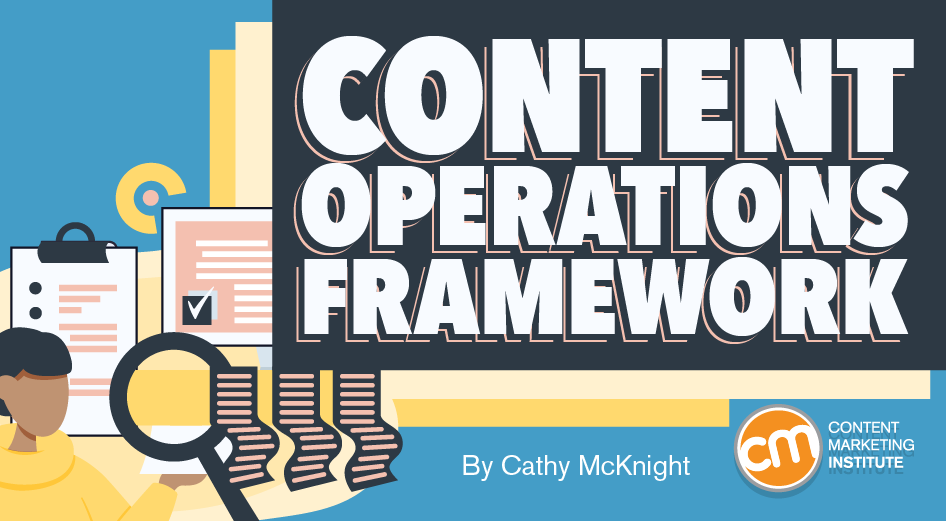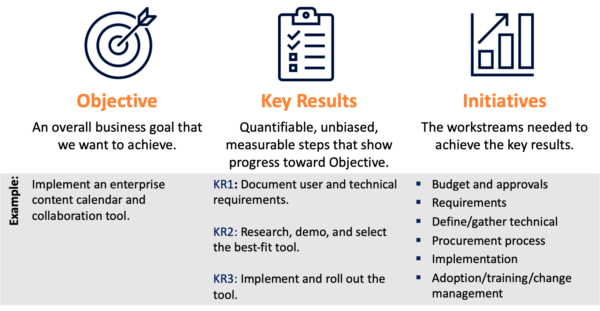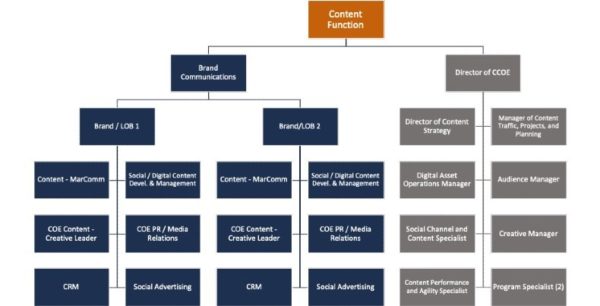MARKETING
Content Operations Framework: How To Build One

More and more marketers of all ilk – inbound, outbound, social, digital, content, brand – are asked to add content operations to their list of responsibilities.
You must get your arms around:
- Who is involved (and, I mean, every who) in content creation
- How content is created
- What content is created by whom
- Where content is conceived, created, and stored
- When and how long it takes for content to happen
- Why content is created (the driving forces behind content creation)
- What kinds of content does the audience want
- How to build a framework to bring order and structure to all of this
The evolving expectations mean content marketers can no longer focus only on the output of their efforts. They must now also consider, construct, implement, and administer the framework for content operations within their organizations.
#Content marketers can no longer focus solely on the output. It’s time to add content ops to the mix, says @CathyMcKnight via @CMIContent. Click To Tweet
What exactly are content operations?
Content operations are the big-picture view of everything content-related within your organization, from strategy to creation, governance to effectiveness measurement, and ideation to content management. All too frequently at the companies – large and small – we consult with at The Content Advisory, content operations are left to evolve/happen in an organic fashion.
Teams say formal content operations aren’t necessary because “things are working just fine.”
Translation: Nobody wants the task of getting everyone aligned. No one wants to deal with multiple teams’ rationale for why the way they do things is the right/best/only way to do it. So, content teams just go on saying everything is fine.
News flash – it’s not.
It’s not just about who does what when with content.
Done right, content operations enable efficacy and efficiency of processes, people, technologies, and cost. Content ops are essential for strategic planning, creation, management, and analysis for all content types across all channels (paid, earned, owned) and across the enterprise from ideation to archive.
A formal, documented, enforced content operation framework powers and empowers a brand’s ability to deliver the best possible customer experiences throughout the audiences’ journeys.
A documented, enforced #ContentOperations framework powers a brand’s ability to deliver the best possible experiences, says @CathyMcKnight via @CMIContent. Click To Tweet
It doesn’t have to be as daunting as it sounds.
What holds many content, administrative, and marketing teams back from embracing a formal content operations strategy and framework is one of the biggest, most challenging questions for anything new: “Where do we start?”
Here’s some help in high-level, easy-to-follow steps.
1. Articulate the purpose of content
Purpose is why the team does what it does. It’s the raison d’etre and inspiration for everything that follows. In terms of content, it drives all content efforts and should be the first question asked every time content is created or updated. Think of it as the guiding star for all content efforts.
In Start With Why, author Simon Sinek says it succinctly: “All organizations start with WHY, but only the great ones keep their WHY clear year after year.”
All organizations start with WHY, but only the great ones keep their WHY clear year after year, says @SimonSinek via @CathyMcKnight and @CMIContent. Click To Tweet
2. Define the content mission
Once the purpose of the teams’ content efforts is clear (and approved), it’s time to define your content mission. Is your content’s mission to attract recruits? Build brand advocacy? Deepen relationships with customers? Do you have buy-in from the organization, particularly the C-suite? This is not about identifying what assets will be created.
Can you talk about your mission with clarity? Have you created a unique voice or value proposition? Does it align with or directly support a higher, corporate-level objective and/or message? Hint: It should.
Answering all those questions solidifies your content mission.
ADVERTISEMENT
The marketer’s field manual to content operations
A hands-on primer for marketers to upgrade their content production process – by completing a self-audit and following our step-by-step best practices. Get the e-book.
3. Set and monitor a few core objectives and key results
Once your content mission is in place, it is time to set out how to determine success.
Content assets are called assets for a reason; they possess real value and contribute to the profitability of your business. Accordingly, you need to measure their efficacy. One of the best ways is to set OKRs – objectives and key results. OKRs are an effective goal-setting and leadership tool for communicating objectives and milestones to achieve them.
OKRs typically identify the objective – an overall business goal to achieve – and three to five key quantifiable, objective, measurable outcomes. Finally, establish checkpoints to ensure the ultimate objective is reached.
Let’s say you set an objective to implement an enterprise content calendar and collaboration tool. Key results to track might include:
- Documenting user and technical requirements
- Researching, demonstrating, and selecting a tool
- Implementing and rolling out the tool.
You would keep tabs on elements/initiatives, such as securing budget and approvals, defining requirements, working through procurement, and so on.

One more thing: Make sure OKRs are verifiable by defining the source and metric that will provide the quantifiable, measurable result.
Make sure objectives and key results are verifiable by defining source and metric, says @CathyMcKnight via @CMIContent. Click To Tweet
4. Organize your content operations team
With the OKRs set, you need people to get the work done. What does the structure look like? Who reports to whom?
Will you use a centralized command-and-control approach, a decentralized but-supported structure, or something in between? The team structure and organization must work within the construct and culture of the larger organization.
Here’s a sample organizational chart we at TCA developed for a Fortune 50 firm. At the top is the content function before it diverges into two paths – one for brand communications and one for a content center of excellence.
Under brand communications is each brand or line of business followed by these jointly connected teams: content – marcom, social/digital content development and management, center of excellence content – creative leader, center of excellence PR/media relations, customer relationship management, and social advertising.
Under the content center of excellence is the director of content strategy, manager of content traffic, projects, and planning, digital asset operations manager, audience manager, social channel and content specialist, creative manager, content performance and agility specialist, and program specialist.
5. Formalize a governance model
No matter how the operational framework is built, you need a governance model. Governance ensures your content operations follow agreed-upon goals, objectives, and standards.
Get a senior-management advocate – ideally someone from the C-suite – to preside over setting up your governance structure. That’s the only way to get recognition and budget.
To stay connected to the organization and its content needs, you should have an editorial advisory group – also called an editorial board, content committee, or keeper of the content keys. This group should include representatives from all the functional groups in the business that use the content as well as those intricately involved in delivering the content. The group should provide input and oversight and act as touchpoints to the rest of the organization.
Pointing to Simon Sinek again for wisdom here: “Passion alone can’t cut it. For passion to survive, it needs structure. A why without how has little probability of success.”
6. Create efficient processes and workflows
Adherence to the governance model requires a line of sight into all content processes.
How is content generated from start to finish? You may find 27 ways of doing it today. Ideally, your goal would be to have the majority (70% or more) of your content – infographic, advertisement, speech for the CEO, etc. – created the same or in a similar way.
You may need to do some leg work to understand how many ways content is created and published today, including:
- Who is involved (internal and external resources)
- How progress is tracked
- Who the doers and approvers are
- What happens to the content after it’s completed
Once documented, you can streamline and align these processes into a core workflow, with allowances for outlier and ad-hoc content needs and requests.
This example of a simple approval process for social content (developed for a global, multi-brand CPG company) includes three tiers. The first tier covers the process for a social content request. Tier two shows the process for producing and scheduling the content, and tier three shows the storage and success measurement for that content:
7. Deploy the best-fit technology stack
How many tools are you using? Many organizations grow through acquisitions, so they inherit duplicate or overlapping functionality within their content stacks. There might be two or three content management systems (CMS) and several marketing automation platforms.
Do a technology audit, eliminate redundancies, and simplify where possible. Use the inherent capabilities within the content stack to automate where you can. For example, if you run a campaign on the first Monday of every month, deploy technology to automate that process.
The technology to support your content operations framework doesn’t have to be fancy. An Excel spreadsheet is an acceptable starting place and can be one of your most important tools.
The goal is to simplify how content happens. What that looks like can vary greatly between organizations or even between teams within an organization.
Adopting a robust content operations framework requires cultural, technological, and organizational changes. It requires sponsorship from the very top of the organization and adherence to corporate goals at all levels of the organization.
None of it is easy – but the payoff is more than worth it.
Updated from a November 2021 post.
HANDPICKED RELATED CONTENT:
Cover image by Joseph Kalinowski/Content Marketing Institute
MARKETING
The key to correcting the C-suite trust deficit

Take a moment to search “CMO tenure” and you’ll find a wide variety of content discussing the short tenure of CMOs and how it’s among the shortest of roles in the C-suite. If you dive deeper, you’ll find that CEOs don’t seem to trust CMOs.
Boathouse’s CMO Insights study (registration required) noted several sobering conclusions:
- 34% of CEOs have great confidence in their CMOs.
- 32% of CEOs trust their CMOs.
- 56% of CEOs believe their CMO supports their long-term vision.
- And only 10% of CEOs believe their CMO puts the CEO’s needs before their own.
If these statistics also apply to the CMO’s entire organization, then it’s clear we have a trust problem with marketing leadership.
If you haven’t read Patrick Lencioni’s “The Five Dysfunctions of a Team,” I consider it required reading for anyone in any leadership role. In his book, Lencioni builds a pyramid of dysfunctions that need to be addressed for a team to succeed. The foundational dysfunction — with which one cannot build a successful team — is “absence of trust.” We see it at scale with marketing organizations today.
Introducing objectivity through data
In “Hamlet,” Shakespeare writes, “There is nothing either good or bad, but thinking makes it so.” Each organization that makes up a company looks at the company from a different perspective. What marketing sees as positive, finance may see as negative. But who’s right? No one.
Usually, there is no objectivity because leadership comes up with an idea and we execute it. It’s like the fashion proverb “Beauty is in the eye of the beholder.” Unfortunately, we’re going to struggle to run a profitable organization if it’s run like a fashion show.
Therefore, we need to introduce objectivity to how we work. Leadership needs to come together to agree on goals that align with the goals of the broader organization. One element of this conversation should be an acknowledgment that this is turning a ship.
Often leaders — especially those without marketing backgrounds — are likely to expect instant gratification. It’s going to take time to turn the ship and you and your team would do well to set reasonable expectations right away.
Dig deeper: KPIs that connect: 5 metrics for marketing, sales and product alignment
Aligning goals and metrics across the organization
With goals in hand, we need to assign metrics to their progress and agree on the source(s) of truth. Once these objective measures are in place, perspective doesn’t matter. 2 + 2 = 4 regardless of whether you’re in HR or accounting.
Every public road has a speed limit and whether you’re in compliance with it has nothing to do with your perspective. If you’re above it, you’re wrong and subject to penalties. Referring to the fashion example, it’s not a fashion show where some people like a dress and others don’t.
By using data to objectively measure marketing’s progress within the organization and having the rest of the leadership buy into the strategy, we build trust through objectivity. Maybe the CEO would not have chosen the campaign the marketing team chose.
But if it was agreed that a >1 ROAS is how we measure a successful campaign, it can’t be argued that the campaign was unsuccessful if the ROAS was >1. In this example, the campaign was an objective success even if the CEO’s subjective opinion was negative.
Data-driven campaign planning
Within the marketing organization, campaigns should always be developed with measurement top of mind. Through analysis, we can determine what channels, creative, audiences and tactics will be most successful for a given campaign.
Being able to tell the leadership team that campaigns are chosen based on their ability to deliver measured results across metrics aligned to cross-departmental goals is a powerful message. It further builds trust and confidence that marketing isn’t run based on the CMO’s subjective opinions or gut decisions. Rather, it’s a collaborative, data-driven process.
For this to be successful, though, it can’t just be for show, where we make a gut decision and direct an analyst to go find data to back up our approach. This would be analytics theater, which is a perversion of the data. Instead, tell the analyst what you think you want to do and ask them to assess it.
For the rest of the organization’s leadership, ask questions when the marketing team presents a campaign. Find out how they came up with the strategy and expect to hear a lot about data — especially the metrics you all agreed would support the company’s overarching goals.
Dig deeper: 5 failure points of a marketing measurement plan — and how to fix them
Data literacy: Building credibility through transparency
Building trust doesn’t happen overnight, but a sustained practice of using data to drive marketing leadership’s decisions will build trust if the metrics ladder up to the organizational goals and all of leadership is bought into the measurement plan.
Over time, this trust will translate into longer tenure and more successful teams through building the infrastructure needed to tackle Lencioni’s five dysfunctions.
Opinions expressed in this article are those of the guest author and not necessarily MarTech. Staff authors are listed here.
MARKETING
How Tagging Strategies Transform Marketing Campaigns


As a marketer, I understand how today’s marketing campaigns face fierce competition. With so much content and ads competing for eyeballs, creating campaigns that stand out is no easy task.
That’s where strategies like tagging come in.
It helps you categorize and optimize your marketing efforts. It also helps your campaigns cut through the noise and reach the right audience.
To help you out, I’ve compiled nine ways brands use a tagging strategy to create an impactful marketing campaign.
Let’s get to it.
How Brands Use a Tagging Strategy
Tagging involves using keywords or labels to categorize and organize content, products, or customer data. You attach tags to specific items or information to make searching, sorting, and analyzing data easier.
There are various types of tags, including meta tags, analytics tags, image tags, hashtags, blog tags, and more.
So, how do brands use a tagging strategy to make their marketing campaigns stand out?
Improve Social Media Engagement
With over 5 billion users, social media provides an easy way to connect with your audience, build relationships, and promote your offerings.


Use a tagging strategy to boost social media interactions. Consistently use hashtags that align with current trends and topics. This encourages people to interact with your content and boosts content visibility.
You can also use tags to monitor brand mentions of your products or your industry. This allows you to engage with your audience promptly.
Consider virtual social media assistants to streamline your tagging strategy. These AI-driven tools can suggest relevant hashtags, track mentions, and automate responses. Implementing them can save time and resources while ensuring consistent engagement across your socials.
Build a Personal Brand on LinkedIn
LinkedIn is the world’s largest professional networking platform, with over 1 billion members across 200 nations. It offers excellent opportunities for individuals and businesses to build and nurture their brands.


However, simply creating a professional profile isn’t enough to build a personal brand on LinkedIn.
Use various tags to increase your visibility, establish thought leadership, showcase expertise, and attract the right connections. For instance, use skill tags to showcase your expertise and industry tags to attract connections and opportunities within your industry. Use certification tags to help showcase your expertise and credibility to potential employers or clients.
Facilitate Customer Segmentation and Personalization
Personalization matters—more so in today’s data-driven world. In fact, 65% of consumers expect your brand to adapt to their changing preferences and needs.
To meet this expectation, consider using a tagging strategy.
Segment your customers based on shared characteristics, such as demographics, interests, purchase history, cart abandonment, and behavior.
Here’s a summary of the steps to customer segmentation.


With your customer segments ready, use tags to tailor your marketing messages and offerings to specific segments. Imagine sending targeted email campaigns based on what your customers need. That’s the power of segmentation and tagging in action!
Enhance SEO and Content Discoverability
Tagging content can have a profound impact on search engine optimization (SEO) and content discoverability. When users search for specific topics or products, well-tagged content is more likely to appear in search results, driving organic traffic to your website.
Additionally, tags can help you analyze the most popular topics with your readers. Then, the results of this analysis can help you adjust your content strategies accordingly.
And get this— certain AI tools can help analyze your content and suggest relevant tags and keywords. Using these tools in addition to a tagging strategy can help optimize your SEO strategies and boost content discoverability.
Partner with the Right Influencers
Influencer marketing has become a go-to marketing approach for modern brands. Recent stats show that 85% of marketers and business owners believe influencer marketing is an effective marketing strategy.
But how do you find the perfect influencer for your campaign?
Utilize tags to identify influencers who are relevant to your niche. Beyond this, find influencers who align with your brand values and target audience.
Additionally, look for influencers who use hashtags that are relevant to your campaigns. For instance, fashion influencer Chiara Ferragni uses #adv (advertising) and #ghd (good hair day) hashtags in this campaign.


Monitor industry-specific hashtags and mentions to discover influential voices and build profitable relationships with them.
Track Hashtag Performance
Tracking your hashtag performance helps you understand your campaigns’ engagement, reach, and effectiveness.
To achieve this goal, assign special hashtags to each marketing project. This helps you see which hashtags generate the most engagement and reach, enabling you to refine your tagging strategy.
Here’s an example of a hashtag performance report for the #SuperBowl2024.


This curated list of hashtag generators by Attrock discusses the top tools for your consideration. You can analyze each and choose the one that best fits your needs.
Categorize Content Accordingly
The human attention span is shrinking. The last thing you want is for your audience to have difficulty in finding or navigating your content, get frustrated, and bounce.


Untagged content can be difficult to navigate and manage. As any marketer knows, content is important in digital marketing campaigns.
To categorize your content, identify the main categories by topics, themes, campaigns, target audiences, or product lines. Then, assign relevant tags based on the categories you’ve identified. After that, implement a consistent tagging strategy for existing and new content.
Organizing your content using tags can also help streamline your content management workflow. Most importantly, readers can easily find the content they’re looking for, thereby boosting overall user experience, engagement, and conversions.
Boost Your Email Marketing Strategy
Email marketing remains a powerful marketing tool in today’s digital world. It’s also another area where brands use a tagging strategy to directly reach their target audience.
Use tags to segment your email list and personalize your marketing messages. Then, you can send targeted emails based on factors like purchase history, interests, and demographics.
Personalization can significantly improve open rates, CTRs, and overall engagement and conversion rates. It’s a simple yet impactful strategy to make your email marketing strategy more effective.
Plus, you can use tags to track how well your emails perform with each group. This helps you understand what content resonates best with your audience and provides insight on how to improve your emails going forward.
Enhance Analytics and Reporting
Every marketer appreciates the immense value of data. For brands using tagging strategies, tags are powerful tools for gathering valuable data.
Analyze how users interact with your tagged content. See which tags generate the most clicks, shares, conversions, and other forms of engagement. Gain insight into audience preferences and campaign effectiveness.
This granular data about your marketing efforts allow you to make data-driven decisions, allocate resources effectively, and refine your marketing strategies.
Final Thoughts
There isn’t a single correct way for brands to use a tagging strategy in marketing. You can use a tagging strategy however you see fit. However, the bottom line is that this strategy offers you a simple yet powerful way to create attention-grabbing and unique marketing campaigns.
Fortunately, tagging strategies are useful across various marketing initiatives, from social media and email marketing to SEO and more.
So, if you’re ready to elevate your marketing campaign, build a strong brand presence, and stand out among the competition, consider employing effective tagging strategies today.
MARKETING
Tinuiti Recognized in Forrester Report for Media Management Excellence

Tinuiti, the largest independent full-funnel performance marketing agency, has been included in a recent Forrester Research report titled, “The Media Management Services Landscape, Q2 2024.” In an overview of 37 notable providers, this comprehensive report focuses on the value B2C marketing leaders can expect from a media management service provider, and analyzes key factors to consider when looking for a media management partner such as size and business scenarios. B2C marketing executives rely on media management services to:
- Augment the efficacy of media investments
- Bridge media impressions to commerce transactions
- Enhance ad campaigns to drive performance
Report authors, VP, Principal Analyst Jay Pattisall and Senior Analyst Nikhil Lai call attention to the pressing need for providers to prove their value, deliver profitable ROAS, and drive alignment between CMOs and CFOs and thus liberate strained marketing budgets.
Our Always-On Incrementality tool – which is a part of our patented tech, Bliss Point by Tinuiti – empowers marketers to validate the incrementality of their spend on each ad set, media channel, and marketing tactic so marketers can create stronger, more focused campaigns that get the job done without sacrificing the bottomline.
B2C marketing leaders often seek and expect key business scenarios from media management service providers including media measurement and attribution, data strategy, and marketing mix modeling. MMM’s adaptability to the post-cookie/ post-IDFA world positions it as an essential tool for marketers. As businesses seek to connect the dots, leverage data, and make strategic decisions, MMM is a crucial ally in the dynamic realm of mixed media advertising. Our Rapid Media Mix Modeling sets a new standard in the market with its exceptional speed, precision, and transparency.
According to the Forrester report, “46% of senior B2C marketing and advertising decision-makers say they plan to integrate performance and brand media assignments with a single media agency in the next 12 months…”
In our quest to better understand all revenue-driving aspects of a given campaign, we have started on a process to quantify the impact of Brand Equity, which we believe is one of the largest missing pieces in more accurate and complete measurement.
Learn more about Bliss Point by Tinuiti, our use cases, and our approach to performance and brand equity.
The Landscape report is available online to Forrester customers or for purchase here.
-
SEARCHENGINES6 days ago
Daily Search Forum Recap: April 29, 2024
-

 MARKETING7 days ago
MARKETING7 days agoQuiet Quitting vs. Setting Healthy Boundaries: Where’s The Line?
-

 MARKETING5 days ago
MARKETING5 days agoHow To Develop a Great Creative Brief and Get On-Target Content
-
SEARCHENGINES5 days ago
Daily Search Forum Recap: April 30, 2024
-

 SEO6 days ago
SEO6 days agoGoogle’s John Mueller On Website Recovery After Core Updates
-

 PPC7 days ago
PPC7 days agoHow to Promote Your Digital Marketing Agency: 4 Growth Strategies
-

 SEO5 days ago
SEO5 days agoWhy Big Companies Make Bad Content
-

 WORDPRESS5 days ago
WORDPRESS5 days ago13 Best Fun WordPress Plugins You’re Missing Out On



















You must be logged in to post a comment Login